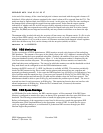
can be used to clean up storage resources and report what data has been lost.
The recover utility has several options. These options are used depending on the severity of
the damage. Refer to the following sections for more information on how and when to use
these options.
The recover utility can only recover data from damaged volumes that are part of a copy set,
and not from just any hierarchy level. The term “secondary copy” as used here means one of
two things: 1) If a volume is a part of a copy set in which data stored in a storage class at a
higher level in the hierarchy is copied directly to each of the storage classes in the copy set.
The most common example is a disk/tape/tape hierarchy in which the disk data is copied first
to the first tape level, followed by the disk data being copied directly to the second tape
level. The two tape storage classes are considered to be part of a copy set, and each tape
volume in the copy set is or has a ‘secondary copy’. 2) If a tape level has a migration policy
with the option ‘Migrate Files’ set (not ‘Migrate Files and Purge’), this level and the next
level form a copy set (assuming the next level does not purge), and each tape volume in the
copy set is or has a ‘secondary copy’.
15.3.1.1. Recover Partially Damaged Disk or Tape Volume
In this situation, a disk or tape cartridge is damaged, and all attempts to repack the damaged volume have
failed. Run recover, which looks for a secondary copy. If found, recover purges all the segments on the
damaged volume and attempts to reconstruct the volume data from the secondary copy. Volumes to
which recover can write must be available in the storage class of the damaged volume. If no secondary
copy is found, recover will report the lost segments but will not purge the segments from the damaged
volume.
15.3.1.1.1. With Secondary Copies
The recover utility is executed with the names of one or more HPSS physical volumes. These volumes
must be in the same storage class. The virtual volumes that contain the suspect physical volumes are
identified and all the storage segments on those virtual volumes are moved to other virtual volumes. All
of the bitfile storage segments are purged from the primary storage level and recovered from the
secondary level.
For example, to run a recovery of two volumes (VOL00100 and VOL00200) that are members of a copy
storage class, enter:
recover VOL00100 VOL00200
The recover utility logs status messages (see the recover man page for status log information) as it tries
to recover damaged segments. The messages should be similar to the following:
========= Trying to recover bitfile =========
003fcadc-53fb-10cf-8c81-02608c2f971f
00336b52 4631 10cf 00 00 00 02
storage level = 1 on VV = VOL00100
path ( Fileset24: /home/bill/file1)
========= Trying to recover bitfile =========
163001bc-2274-10ef-8c81-02608c2f971f
00336b52 4631 10cf 00 00 00 02
HPSS Management Guide November 2009
Release 7.3 (Revision 1.0) 362


















